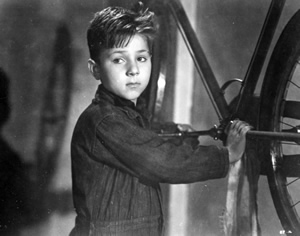Bicycle Thieves (1948)
 Directed by Vittorio De Sica
Directed by Vittorio De Sica
Screenplay by Cesare Zavattini (from a novel by Luigi Bartolini).
Written by Cesare Zavattini (and others). Bicycle Thieves tells several stories. The film seems to be about Antonio Ricci, the theft of his bicycle, and his futile search for it. However, the deeper and more important one, the one that makes this a classic film (and a tragedy), is the story of his son Bruno and his loss of faith in and eventual acceptance of his father. Bruno is a young child and, at the beginning of the the film, has a child's understanding. His world is his family and his hero is his father. He has little self-awareness. As the film progresses, Bruno comes to learn more about the world. He learns that he is from an impoverished family and his father is powerless. But, this knowledge leads him to draw closer to his father and empathize with him in a new way. Almost all of the film takes place on a single day, but Bruno is much older at the end of the day than he was at its start. Set in the grim streets of post-war Rome, Bicycle Thieves afocuses attention on class differences, the role of the church, and the cyclical nature of poverty.
Bicycle Thieves comes late in the brief neo-realist cannon. Its techniques are somewhat more polished and its production more expensive than earlier neo-realist films such as Germany Year Zero. However, it retains most of the characteristics of neo-realist film making including the use of an almost entirely amateur cast, location filming, unpaid extras, dialogue added after filming, and so on.
Staring:
Lamberto Maggiorani (1909-1983), (Antonio Ricci) had been a machinist at the Breda steelworks for 16 years when he was chosen to play Antonio. For his part he was paid 600,000 lire, a bit less than $1,000 in the money of the era (about $13,000 in 2024). After the film, he returned to the steelworks but was laid off soon afterwards. He claimed that his fellow workers believed that he had made millions and that he was let go for that reason. Unemployed after the film, he is reported to have said that he wished he had never been in the film. Cesare Zavattini was aware of Maggiorani's plight and wrote a screenplay for a movie that blended elements of Bicycle Thieves, a move called Gilda (in Bicycle Thieves Antonio is hanging a poster for that movie when his bicycle is stolen) and Maggiorani's actual life after the movie. But the film was never made. Maggiorani did have minor roles in more than a dozen films in the 1950s and early 1960s but Bicycle Thieves remained the highpoint of his career. So, ironically, a movie that was fundamentally about the exploitation of the downtrodden laborer added to the exploitation of a specific downtrodden laborer.
Enzo Staiola (1939-2025), (Bruno Ricci) was 7 at the time of the filming. Like Maggiorani, he took minor roles in numerous films after Bicycle Thieves, mostly between 1949 and 1954. By far the most famous of these was the 1954 Joseph Mankiewicz film The Barefoot Contessa staring Humphrey Bogart and Ava Gardner. However, also like Maggiorani, he is best remembered for this single role. Staiola left film making in the mid 1950s when he was still a teen. He spent his adult career as a clerk in the Land Registry office and as a math teacher. He almost surely has had a happier life than Maggiorani. Here's an interview with him conducted in 2013
Interview with Enzo Staiola from Triworld Cinema on Vimeo
Lianella Carell (Maria Ricci) was a journalist who tried to interview de Sica. She went on to a fairly extensive career in the movies, playing an additional 17 roles in the following ten years.
Gino Saltamerenda (Baiocco) was the only professional actor in the film. de Sica had used him before, in Shoeshine, and he went on to play in another 8 films before his death in 1951.
Bicycle Thieves is widely considered to be one of the top 100 films of all time.
Next: Film Noir
 My Analysis of Bicycle Thieves
My Analysis of Bicycle Thieves
Roger Ebert review (1969) (required)
Paul Bradshaw review (2008) (required)